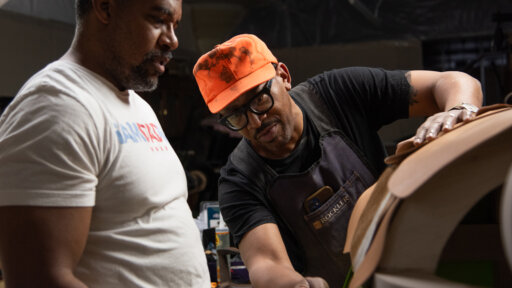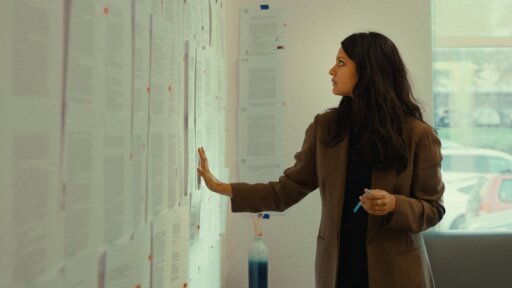TRANSCRIPT
(gentle music) (birds twittering) (spirit level clattering) (paper rustling) (music drowns out speaker) (paper rustling drown out speaker) (gentle music) - [Maryam] We use something like 7,000 words a day, so it's the most used tool for communication.
Okay, there's one missing here.
It needs to be right there.
We rely on it more than anything else.
- In a cluster.
- Perfect.
(people chattering) (gentle music) - Okay, perfect.
- Okay.
(gentle music) - A part of what I am doing is to actually look beyond language, because language is insufficient to wrap the whole existence.
(gentle music) Let's see, this is giving me trouble today.
(wooden blocks clattering) (airbrush hissing) The airbrush, I keep thinking about it as breath, inhale and exhale and repeat something over and over again, tuning into a certain kind of mental space, which you do with meditation.
(airbrush hissing) The action itself becomes secondary to what comes out of it.
(gentle music) - The architectural installation just so you know, I wrote that question.
I'm leading you to talk about the type of spaces that don't exist in western culture, which is these in-between spaces.
- One of my eyebrows has jumped.
- I think that even people that know your work will see something that they- - Haven't seen before, yeah, yeah, yeah.
I was born and raised in Tehran and I would say that the earliest memories I have of drawing is from these lessons in calligraphy where we had to trace the form of a letter.
When I was in my undergrad year in Vancouver, I was scribbling a lot in Persian and they organically became drawings and I was showing them in class, and I knew that this language is going to always read as illegible in this new place.
(haunting music) The use of Persian language in my work has been a way of grappling with my own reality as someone who is displaced from the language, from its emotional and psychological space.
I started looking at these talismans scripts that are believed to possess magical powers.
We use something that we know and we recognize as letter forms, but we want them to connect us to something that is invisible, unseen.
So I was tracing these and I was also making stencils, and the noqte are these dots that are either on the top or below a letter form, and in calligraphy they become a unit by which you measure the proportions of the letter forms.
Imagine the nip of a reed pen.
When you draw it out, you get this diamond shape.
I decided to pluck the noqte out of the language and place it to measure the horizon.
In a way, if I am using these noqtes, I am saying that this language is still with me, even if it's illegible, this is such a signifier of the language.
(glass clinking) (airbrush hissing) (metal cap clinking) (paper rustling) It is been really meditative to work with this one element.
Giving space for that obsessiveness keeps my mind together, but with the noqte it definitely had to be a lot of precision and execution of the form itself.
I minimize decision-making in certain ways.
I'm going to spray these four times or five times, not twice, not 10 times.
Keep that steady.
I am fascinated in thinking about color as light, and I try to replicate that in my paintings where there is not a clear edge between one color and another.
(air brush hissing) The fine tuning could be done forever, so I have to figure out like just stop when I need to stop.
That feels unresolved.
(clothing rustling) There's a point where you stop seeing.
I have like six or seven more to make.
(car engine whooshing) Like making art is so much about like summiting your demons, then taming them, you know?
It's like, it's a really deep process, psychological process and you know, giving myself the permission to fail is important.
Whatever it is, you just have to welcome it in it's full form.
(door thuds) (gentle music) Even though in the back of my mind I always thought the distance would resolve itself, the distance from home, from family, from all these things that feel really first nature, that accumulates over time.
- There we go.
- I am thinking that I need to show it the other orientation because then these will have the wrong orientation, so I think I just have to show it with the bottom down.
- There's two cutouts in the bottom though.
- Yeah, but there is, yeah.
Oh, shit, right.
I have all these threads, but then I'm like how disconnected this feels now.
I have lived more than half of my life away from people who love me, from the language that I am very in tune with.
The distance never really went away.
It just accumulated in this weird way and there are moments where it just erupts.
This might be something that I ask you to build, small legs that lift it off the ground a little bit.
Then it makes these holes meaningful.
I'm really conscious that I have no idea what it feels like to live in Iran right now.
I am so far removed and maybe my practice is a way of like keeping my relationship intact and being able to create spaces where these conversations are still ongoing and they don't die.
(water whooshing) (pin clattering) (paper rustling) I have thought about noqte mostly as this measuring unit and one of the things that I was thinking about is how we use different systems to give meaning to the world and find ways to invent our own measuring units.
In calligraphy, it's this unit that is determining the relationships within the system of aesthetic that is meant to evoke beauty.
So it's like taking something into a whole new environment where they are put into this new context where there are more possibilities for them to be perceived, but they have been separated from where they were intended to be.
(clothing rustling) (speaking foreign language) (bright music) (crowd chattering) (speaking foreign language) (crowd loudly chattering) (crowd chattering drowns out speaker) Exactly, it becomes all reflective, so then see you it many, many times.
(crowd loudly chattering) (gentle music) The horizon is a fascinating phenomenon that our eyes can see that far in this sense, but in order to do that, it has to make its own interpretation, converging the sky and earth.
(water whooshing) Even language tries to measure our experience and yet there's so much that's immeasurable.
(gentle music) (graphic clacks) (bright gentle music)













